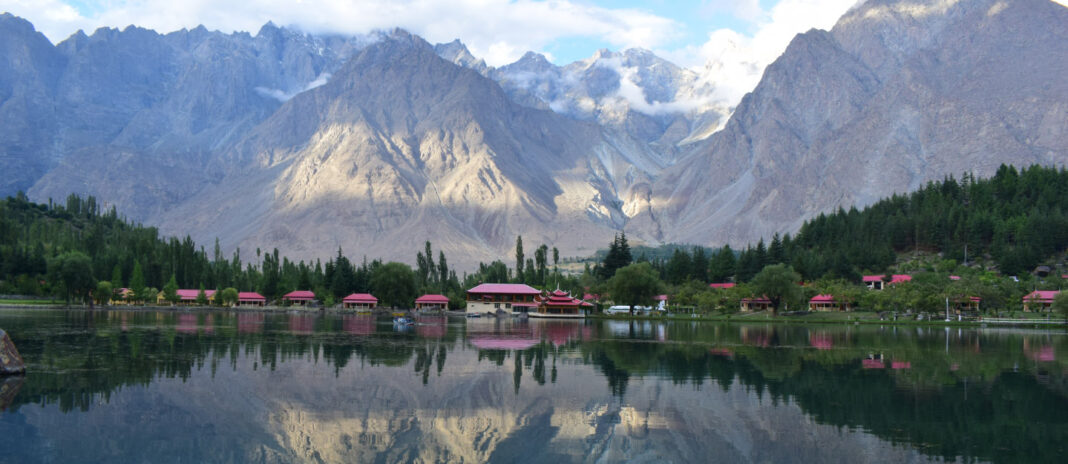By: Naveed Akhtar
Gilgit-Baltistan is a scenic region that lies in the northernmost part of Pakistan. Gilgit-Baltistan nestles a spectacular natural landscape including three mountain ranges, Glaciers, waterfalls, streams, cold deserts, historical assets, and mesmerizing meadows. The region possesses rich mineral deposits, including precious and semi-precious gemstones, metallic minerals, industrial minerals, and building stones. Gemstones such as ruby, aquamarine, topaz, emerald, and tourmaline have been found in various parts of the region. Additionally, deposits of gold, copper, lead, zinc, limestone, marble, and granite offer immense opportunities for mining operations. Gilgit-Baltistan’s geo-strategic location further heightens its significance as this region is the only gateway to China i.e. Pakistan’s all-weather friend and crucial geo-strategic and defense partner. The region shares its border with Pakistan’s historic arch-rival and prominent economic power in South Asia i.e. India. It lies close to Central Asian countries, which are landlocked countries and rich in natural resources like oil, gas and other minerals, through land. Gilgit-Baltistan could provide exclusive and easy access for China, and Pakistan to reach Central Asia by land and expand its market to Central Asia.
Beyond all the natural blessings and the region’s geo-political and economic importance, Gilgit-Baltistan suffers from two basic challenges i.e. changing climate and fundamental constitutional rights. Gilgit-Baltistan’s quest for identity has never-ending sacrifices and struggles that have remained alive for a long time. Climate change is a matter of utmost challenge that is a survival risk to mountain communities. The region hosts more than 7000 glaciers and according to a UNDP report, there are around 3,044 new glacier lakes that have been formed as a result of glaciers melting at an unprecedented rate due to human activities contributing to global warming. Flash floods, mudflow and unprecedented and unusual rain and snow patterns have been devastating for the region’s human, food, water and community security. Natural great calamities are worsening life in the mountains where due to any natural calamities local communities and their belongings come under devastation. Infrastructure and people-to-people connectivity by land are damaged and disrupted. People living at high altitudes remain disconnected by land as well as by technology as many mountain communities are still forced to live in stone ages with no network, internet, or technologies. In 2023 flash floods wreaked havoc across Gilgit-Baltistan, causing damage to standing crops and corn fields, cherry and apricot orchards, damages to irrigation channels or hydropower stations have been also recorded which worsened the already vulnerable communities suffering a lot under poverty, least technological and infrastructure development.
High floods in various nullahs in Ghizer, Nagar, Hunza, Skardu, Ghanche, and Shigar districts frequently result in total irreparable damages. The region has no financial structure to adopt climate mitigation strategies and work to raise awareness programs locally and as well as nationally to alert stakeholders about the consequences of climate change to the mountain communities. The region budget for FY 2023-24 with a total outlay of over 116 billion rupees, 74 billion rupees have been allocated for non-development expenditures while over 28 billion rupees have been allocated for developmental expenditures. Less than 15% budget for the development budget is a huge concern and a signal that authorities and policymakers are slumbering with no focus on getting the mountain communities out of trouble as a result of climate change triggering flash floods, mudslides and unusual snow and rain patterns challenging local farmers.
Gilgit-Baltistan tourism is now at its peak during spring and summer times when local and international tourists in bulk amount visit the region. Currently, according to a report more than half of the Gilgit-Baltistan population is directly or indirectly dependent upon tourism. With access to regional fruits and dry fruits in national and export markets, the region has been witnessing progress in the living conditions of people, getting employment opportunities in the tourism industry. However, the rise in the tourism industry leaves a region prone to more environmental hazards. Tens of thousands of tourists visit the region which in some way is appealing but at the other end is gradually retarding the ecosystem. Gilgit-Baltistan geo strategic importance is deeply rooted in China’s One Belt One Road initiative that aims to connect more than 145 countries’ markets with China via road channels and infrastructure like railways, highways, dry ports, etc. In 2013 President of China announced the CPEC (China-Pakistan Economic Corridor) valued at $46 Billion initially but now it is estimated at around $65 Billion. CPEC is welcomed and considered as Game changer for Pakistan’s economy. Gilgit-Baltistan is the only road to link China and Pakistan and hence it is a gateway for CPEC.
Also, the region began hosting international flights direct from Dubai in 2023, this year international flight is scheduled from 29th April 2024, with two flights every week between Skardu and Dubai. This is a landmark and historic to further boost the tourism sector of the region and improve livelihood while generating more job opportunities and markets.
Gilgit-Baltistan’s ecosystem is at risk from growing commercial and trade activities between borders. Trade and commercial activities are welcoming but strategies and measures are necessary to cope with the consequences that these trade and commercial activities imprint on the region’s ecosystem. Sustainable Policies and financial structures are necessary to ensure sustainable trade and human activities which is the need of the hour to save generations and ecosystems from further devastations and calamities.
The writer is a student of International Relations. He can be reached at [email protected]





